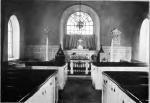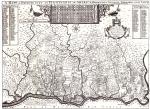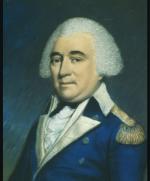![header=[Marker Text] body=[Erected in 1715 by Welsh Episcopalians, renovated 1871. Commemorated by Longfellow's poem. Final burial place of Gen. Anthony Wayne, whose remains were brought to Erie in 1809. ] sign](http://explorepahistory.com/kora/files/1/10/1-A-3CC-139-ExplorePAHistory-a0n1t8-a_450.jpg)
Mouse over for marker text
Name:
St. David's Church
Region:
Philadelphia and its Countryside/Lehigh Valley
County:
Delaware
Marker Location:
SR 1046 (St. David's Rd.) at SR1017, 2 miles SW of Wayne
Dedication Date:
October 13, 1947
Behind the Marker
Immortalized by Longfellow in a poem written after his March 1880 visit, St. David's Church in Wayne, Radford Township, has a deep history dating to the first Welsh settlers to inhabit the so-called "Welsh Tract" on the banks of the Schuylkill River west of Philadelphia. Named for the patron saint of Wales, this beautifully simple fieldstone structure and its adjacent graveyard serve as a tangible reminder of the early Welsh presence in colonial Pennsylvania.
By the time the "Old St. David's Church" cornerstone was laid 1715, Welsh settlers had been in southeastern Pennsylvania for two generations. The earliest Welsh settlers arrived in 1683 following the creation of the 40,000 acre "Welsh Tract," a vast territory in which proprietor William Penn permitted the use of the Welsh language because many of the settlers spoke no English.
Drawn by William Penn's promise of religious toleration and the economic opportunities of arable farmlands, settlers came primarily from the northern counties of Wales. Many of the early leaders were Quakers like Penn, and they kept close ties to brethren at home. Philadelphian Robert Turner, who owned thousands of acres, offered the area of Gwynedd as an early Welsh settlement site. One of the largest contingents of Welsh settlers arrived in the spring of 1698 after a three-month voyage out of Liverpool, with an extended stay in Dublin.
Throughout the 1700s a rising tide of Welsh Anglicans settled in the southern region of the tract, near present-day Wayne and Radnor in Delaware County. Although they were members of the English established church, their Welsh identity was strong. When the early settlers gathered in each others' homes for worship they read from native-language bibles and sang from a Welsh hymnal. They petitioned the Society for the Propagation of the Gospel in London to assign a Welsh-speaking missionary. And when they constructed a church in Radford Township in 1715, they named it after St. David, the patron saint of Wales. A stone taken from the Welsh Cathedral of St. David was brought across the ocean and placed in the new church's entry gable.
During the Revolutionary War, the rural stone church served as a shelter for soldiers on both sides of the conflict. Members experienced a crisis of sorts when Rector William Currie resigned his position due to the oath he had sworn to be loyal to the king. It took more than ten years for another pastor to be assigned. The war created its own divided loyalties in governance and in parish life. Native son and Revolutionary General Anthony Wayne is buried in the church graveyard. The war hero's body was originally interned at Presque Isle outside Erie, but in 1809 Wayne's his son, Isaac, made a 900-mile trek to bring his father's remains back to the family plot at Old St. David's.
General Anthony Wayne is buried in the church graveyard. The war hero's body was originally interned at Presque Isle outside Erie, but in 1809 Wayne's his son, Isaac, made a 900-mile trek to bring his father's remains back to the family plot at Old St. David's.
The completion of the "Main Line" of the Pennsylvania Railroad in the early 1830s opened suburban Philadelphia to more rapid population growth, and created a new artery for western migration across the Susquehanna River. More than a few Welsh laborers helped to complete the railroad to Columbia. Welsh settlers continued to push westward across the frontier. To this day one finds evidence of rural Welsh communities and cemeteries across the Commonwealth's southern tier, especially in Chester, Lancaster, and York counties.
At the same time, the growing demand for anthracite coal drew a small but steady stream of Welsh immigrants into the northeastern counties where they entered the mines and collieries of the industrial revolution. In the hard-scrabble ethnic politics of the coal region, Welsh-Protestant mine families avoided much of the prejudice and controversy that Irish-Catholic immigrants faced.
Once rural and isolated, St. David's Church is today the largest Episcopal parish in Pennsylvania, with more than 3,000 members. Very much a suburban congregation that has taken care to preserve its heritage, the parish complex is now a historic property of several structures and the well-maintained graveyard. The original stone chapel is now a fellowship hall. A new parish house was built in 1924 and enlarged in the 1950s. In 1965, the Bishop of St. David's in Wales was present to celebrate the community's 250th anniversary. A 650-seat chapel was completed in 2006, and a new organ installed the next year.
"What an image of peace and rest
Is this little church among its graves!
All is so quiet: the troubled breast,
The wounded spirit, the heart oppressed,
Here may find the repose it craves."
-Henry Wadsworth Longfellow (1880)
Immortalized by Longfellow in a poem written after his March 1880 visit, St. David's Church in Wayne, Radford Township, has a deep history dating to the first Welsh settlers to inhabit the so-called "Welsh Tract" on the banks of the Schuylkill River west of Philadelphia. Named for the patron saint of Wales, this beautifully simple fieldstone structure and its adjacent graveyard serve as a tangible reminder of the early Welsh presence in colonial Pennsylvania.
By the time the "Old St. David's Church" cornerstone was laid 1715, Welsh settlers had been in southeastern Pennsylvania for two generations. The earliest Welsh settlers arrived in 1683 following the creation of the 40,000 acre "Welsh Tract," a vast territory in which proprietor William Penn permitted the use of the Welsh language because many of the settlers spoke no English.
Drawn by William Penn's promise of religious toleration and the economic opportunities of arable farmlands, settlers came primarily from the northern counties of Wales. Many of the early leaders were Quakers like Penn, and they kept close ties to brethren at home. Philadelphian Robert Turner, who owned thousands of acres, offered the area of Gwynedd as an early Welsh settlement site. One of the largest contingents of Welsh settlers arrived in the spring of 1698 after a three-month voyage out of Liverpool, with an extended stay in Dublin.
Throughout the 1700s a rising tide of Welsh Anglicans settled in the southern region of the tract, near present-day Wayne and Radnor in Delaware County. Although they were members of the English established church, their Welsh identity was strong. When the early settlers gathered in each others' homes for worship they read from native-language bibles and sang from a Welsh hymnal. They petitioned the Society for the Propagation of the Gospel in London to assign a Welsh-speaking missionary. And when they constructed a church in Radford Township in 1715, they named it after St. David, the patron saint of Wales. A stone taken from the Welsh Cathedral of St. David was brought across the ocean and placed in the new church's entry gable.
During the Revolutionary War, the rural stone church served as a shelter for soldiers on both sides of the conflict. Members experienced a crisis of sorts when Rector William Currie resigned his position due to the oath he had sworn to be loyal to the king. It took more than ten years for another pastor to be assigned. The war created its own divided loyalties in governance and in parish life. Native son and Revolutionary
The completion of the "Main Line" of the Pennsylvania Railroad in the early 1830s opened suburban Philadelphia to more rapid population growth, and created a new artery for western migration across the Susquehanna River. More than a few Welsh laborers helped to complete the railroad to Columbia. Welsh settlers continued to push westward across the frontier. To this day one finds evidence of rural Welsh communities and cemeteries across the Commonwealth's southern tier, especially in Chester, Lancaster, and York counties.
At the same time, the growing demand for anthracite coal drew a small but steady stream of Welsh immigrants into the northeastern counties where they entered the mines and collieries of the industrial revolution. In the hard-scrabble ethnic politics of the coal region, Welsh-Protestant mine families avoided much of the prejudice and controversy that Irish-Catholic immigrants faced.
Once rural and isolated, St. David's Church is today the largest Episcopal parish in Pennsylvania, with more than 3,000 members. Very much a suburban congregation that has taken care to preserve its heritage, the parish complex is now a historic property of several structures and the well-maintained graveyard. The original stone chapel is now a fellowship hall. A new parish house was built in 1924 and enlarged in the 1950s. In 1965, the Bishop of St. David's in Wales was present to celebrate the community's 250th anniversary. A 650-seat chapel was completed in 2006, and a new organ installed the next year.
Beyond the Marker









